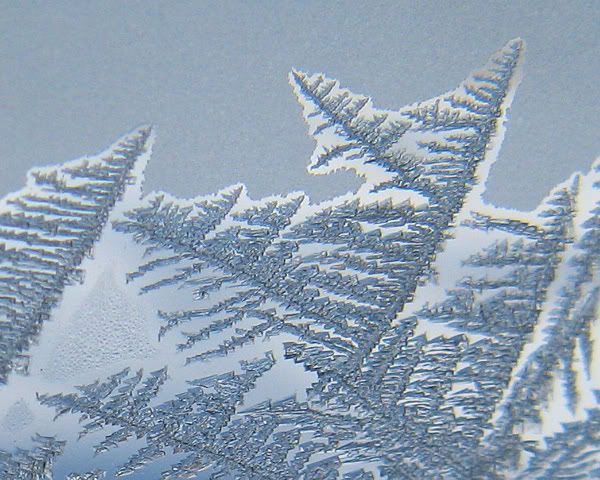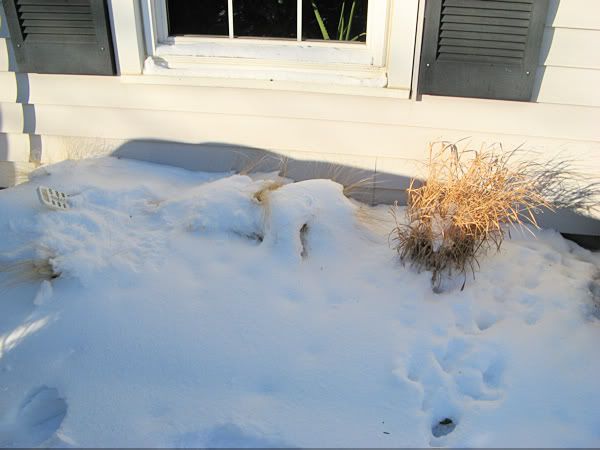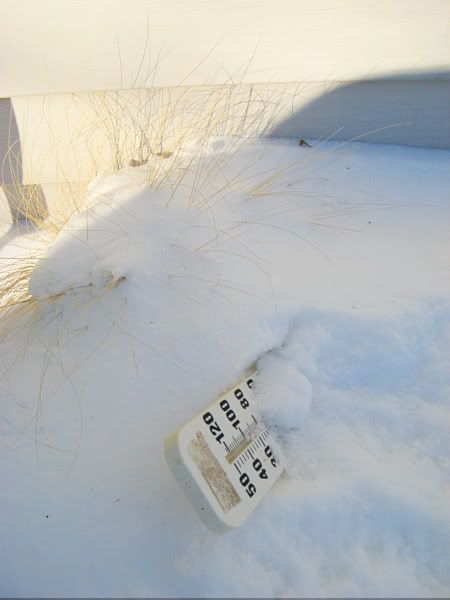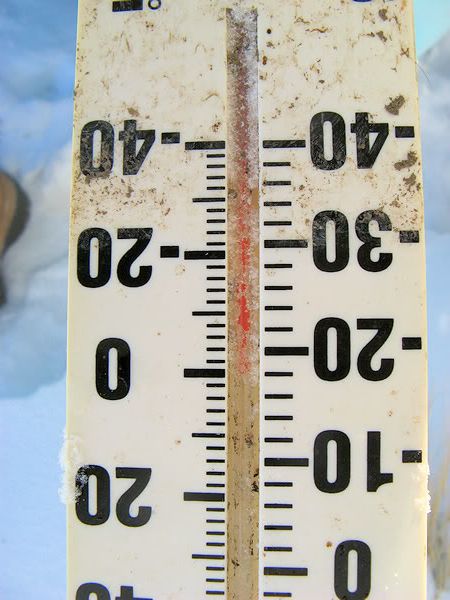While contemplating how quickly the days might pass by until I can board a plane and soar to a warmer place, a thought popped into my head. I wonder if the temperature under a layer of snow is warmer than it is in the open air? 
What!? The two are related!
We who live in the frozen tundra throughout the winter months give these things some thought. We have precious perennials that have to get through the winter and sometimes it's as tough on them as it is us.
I live and garden in USDA Hardiness Zone 5b, which means (among other things) that perennials have a good chance of surviving temperatures of -15°F to -10°F. That's air temperature, not wind chill. Plants, unlike humans and animals, are not affected by wind chill, although the winds themselves can be damaging to woody plants.
Just outside our family room window, on the south side of the house, we have a microclimate. I'm convinced that it's a full zone warmer there than any other location on our property. It gets the warmth of a southern exposure to the sun, as well as being mostly protected from strong winds by a row of yews that run diagonally from the corner of the house to the southeast.
This fall, I planted some marginal plants in this area, in an experiment in trying to see if they would winter over. Coreopsis 'Limerock Dream' (Coreopsis, Zones 6-9) and Mexican Feather Grass (Stipa tenuissima, Zones 7-10) are there, as well as a young Maypop (Passiflora incarnata, Zones 6-10). The Maypop was shared with me from a fellow garden blogger, Kathy at Tangled Branches.
That was an experiment in itself, yet to give results. May will tell the story. But what about this -20°F stuff we had a couple of days ago? That's well below the limit of Zone 5.
As the snow came down earlier this week, I was happy to see it. Snow is a great insulator for these plants we grow and love. Without it, only the strong survive the coldest temperatures. With most perennials, we're concerned mainly with the root structure and the crown of the plant, not with what may be left standing up in the air. There's warmth in the ground and we want it to stay there. Mulch helps. And so does snow. Think of it like bubble wrap. The pockets of air in snow are what help prevent the warmth from escaping the ground. Snow is a good thing.
There's warmth in the ground and we want it to stay there. Mulch helps. And so does snow. Think of it like bubble wrap. The pockets of air in snow are what help prevent the warmth from escaping the ground. Snow is a good thing.
Now, back to what I wanted to know in the first place, and the reason for this blog post. Is the temperature down under the blanket of snow warmer than the air temperature? I put the thermometer down in the snow as far as I could and left it in place for about thirty minutes. The thermometer outside read -5°F.
 The thermometer reads 0°F
The thermometer reads 0°F
















 "Bejeweled"
"Bejeweled"



13 comments:
You'll get no argument from me. The snow cover is a great benefit.
We had so much snow here a few weeks ago, so unusual to have that much (almost 2 feet). But I'm convinced the reason some of my flowers are blooming already is that the snow kept them insulated from how cold it got.
Interesting Kylee, 5 degree difference... hm I think it depends on how cold it is in the air, the difference are sure to be bigger if it is much colder in the air.
One thing is for sure some plants could survive without the cover of snow.
Take care/ xoxo Tyra
Hey, I've always wondered about that myself. Thanks for doing it so I don't have to. I've planted some plants that only survive in zone 7 too, and as long as they're close to the foundation they always came up. I'm anxious to see if your passiflora makes it because I've wanted to plant that one here too.
It is often said that snow cover is good for plants. Now we can see why.
I bet the ground may even be a bit warmer. Who knows? Sounds like a great experiment to me!
Snow cover definitely acts as a layer of insulation for plants. :) I'm glad you were able to prove your hypothesis!
Good luck with your "experiment" plants, Kylee. I have a south-facing wall similar to yours and have good luck with pushing the zone limits there. A hydrangea macrophylla--one that's supposed to bloom only on old wood, but dies to the ground every year here, and that has refused to bloom in three other spots in my yard--finally bloomed in that southern spot last year! (It's shaded from the hot sun by a taller shrub.) I actually stood in my yard hooting and hollering when I saw it. Whether it's the location, the snow protection, or some combination of factors, I don't know, but I think your coreopsis and friends may do just fine.
Never would have know that !
Thanks for the info.
Any other idea's up your sleeve ?
I've always heard that snow is an insulator. I believe you've proved it! The blank is keeping the ground 5 degrees warmer.
The south-facing microclimate in my front cottage garden is definitely a zone (at least) warmer. The L-shape garage blocks the west and the house blocks the north. I have a gardenia in the corner by the front porch that has never seen frost, not even with our 8 degrees the other day. The petunias still have green leaves and the tall verbena is still green.
Cameron
I was just explaining this phenomenon to Hubby over the weekend! I'm so glad you did this experiment. Now I can send him over here to read it (which he'll LOVE because he's a weatherman as heart).
Cindy
Good for you, Kylee! Perhaps experiment #2 might be putting a thermometer in the frost line and then another below the frost line? ;-)
EAL ~ I was glad to see it snow before we got such cold temps. I like snow anyway, but I knew the plants were going to need the protection, too!
gardenerprogress ~ That's a lot of snow! Flowers blooming! Yay!
Tyra ~ The air temperature was five degrees colder (-5 F.). Plants aren't affected by wind chill like people are, so the difference was only five degrees. But it could make all the difference!
flydragon ~ I'll be sure to post the results of trying to overwinter these plants. I'm pretty hopeful!
Lisa ~ Well, it satisfied my curiosity for the time being!
Cinj ~ I wonder that, too, and I'll bet it is. But I'm not going to spend enough time out there or try to dig in it to find out! LOL
Nancy ~ So am I. It was fun to do.
Donna ~ Thanks for the encouragement! I think if they survive this winter, I'll consider them hardy for me!
Patsi ~ Oh, you never know. Nothing at the moment, but these things pop into my head, usually at odd moments. LOL.
Cameron ~ You'd sure think 8 degrees would do just about any tender plant in, wouldn't you? I'm hoping the plants in this area make it. It was -20 F the other night!
Cindy ~ Just tell him how nice and toasty it can be in an Eskimo igloo!
Shady Gardener ~ Oh dear! The frost line here is 36 inches! That would not be a fun task, especially with the clay we have here! It would be interesting though, wouldn't it?
Post a Comment